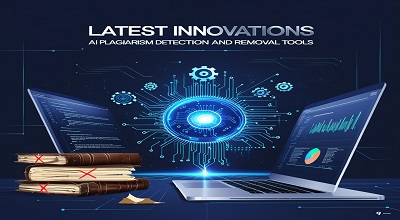AI-driven Plagiarism Detection
Plagiarism has been a persistent issue across industries, particularly in education, publishing, and content creation. With the evolution of technology, the tools used for plagiarism detection have also advanced significantly. Today, artificial intelligence (AI) has revolutionized the landscape of plagiarism detection and removal, making the process more efficient and reliable. This article explores the latest developments in AI-driven plagiarism detection and removal tools, highlighting their features, benefits, challenges, and potential future advancements.
Introduction
Plagiarism occurs when someone uses another person’s work without proper acknowledgment, presenting it as their own. In academic institutions, it compromises the integrity of education, while in content creation and publishing, it can lead to legal and reputational damages. Detecting and addressing plagiarism has become paramount, and AI has emerged as a powerful ally in this effort. By employing machine learning algorithms, natural language processing, and other advanced technologies, AI-driven tools are setting new benchmarks in plagiarism detection and prevention.
What Are AI-driven Plagiarism Detection Tools?
AI-driven plagiarism detection tools are software solutions designed to identify copied or improperly cited content. Unlike traditional methods that rely on simple keyword matching, these tools leverage complex algorithms to analyze context, sentence structures, and semantics, providing more accurate and nuanced results.
Key Features:
- Contextual Analysis: AI tools can understand the context of content, making it easier to detect paraphrased text.
- Multi-language Support: Many tools now support plagiarism detection across multiple languages.
- Real-time Scanning: Advanced tools can perform real-time checks, making them suitable for live content publishing platforms.
- Cloud Integration: Cloud-based tools allow seamless integration with other applications, enabling broader use.
The Role of AI in Plagiarism Detection
AI enhances plagiarism detection by addressing the limitations of traditional methods. Let’s explore some key aspects where AI is making a difference:
1. Improved Accuracy
AI algorithms can differentiate between correctly cited and plagiarized content. By analyzing sentence structures and patterns, they reduce false positives and negatives.
2. Paraphrase Detection
Traditional tools often fail to detect paraphrased content. AI tools, however, employ semantic analysis to identify similarities in meaning even if the wording is different.
3. Cross-domain Analysis
AI can scan multiple sources across various domains, including academic journals, blogs, and social media, ensuring thorough plagiarism detection.
4. Learning and Adaptability
Machine learning allows AI tools to improve over time. As they process more data, their accuracy and efficiency in detecting plagiarism improve.
Top AI-driven Plagiarism Detection Tools in 2025
1. Turnitin
A leading name in academic integrity, Turnitin uses AI to provide in-depth plagiarism checks, feedback, and grading tools.
Features:
- Advanced similarity report
- Grammar and spell-check integration
- Comprehensive citation analysis
2. Grammarly
Known for its grammar-checking capabilities, Grammarly also includes a plagiarism checker powered by AI.
Features:
- Instant plagiarism detection
- Paraphrase and rewrite suggestions
- Source citation assistance
3. Copyscape
Copyscape is popular among content creators and publishers for its reliable plagiarism detection.
Features:
- Website plagiarism checks
- Batch search for multiple files
- API integration for custom solutions
4. Quetext
Quetext combines simplicity with advanced AI capabilities, offering a seamless user experience.
Features:
- DeepSearch™ technology for better accuracy
- Citation generator
- Multiple file format support
5. Plagscan
Plagscan’s AI-based solutions cater to educational institutions and businesses alike.
Features:
- Multi-language support
- Integration with Learning Management Systems (LMS)
- Detailed plagiarism reports

Benefits of AI-driven Plagiarism Detection Tools
1. Time Efficiency
AI tools process vast amounts of data in seconds, significantly reducing the time required for plagiarism checks.
2. Enhanced Reliability
The advanced algorithms minimize errors, offering more reliable results compared to manual or traditional tools.
3. Customizable Options
Users can tailor the tools according to their specific needs, such as focusing on particular sources or domains.
4. Accessibility
Cloud-based tools allow users to perform plagiarism checks from anywhere, anytime.
5. Educational Value
Many tools provide feedback on writing quality, helping users improve their writing and citation skills.
Challenges and Limitations
Despite their advantages, AI-driven plagiarism detection tools are not without challenges:
1. False Positives
Occasionally, AI tools may flag common phrases or properly cited content as plagiarism.
2. Cost
Advanced tools with extensive features often come with subscription fees, which may not be affordable for all users.
3. Dependence on Technology
Over-reliance on these tools may discourage individuals from developing their own critical writing and citation skills.
4. Ethical Concerns
The use of AI tools raises questions about data privacy and the potential for misuse.
Emerging Trends in AI-driven Plagiarism Detection
1. AI-powered Writing Assistants
Combining plagiarism detection with writing assistance, tools like Grammarly are evolving into comprehensive writing platforms.
2. Blockchain Integration
Blockchain technology is being explored to create immutable records of original content, preventing plagiarism before it occurs.
3. Real-time Detection for Live Platforms
AI tools are being developed to detect and flag plagiarized content on live publishing platforms instantly.
4. AI in Education
Educational institutions are integrating AI tools into their learning management systems for seamless plagiarism checks.
Conclusion
AI-driven plagiarism detection and removal tools are reshaping how we approach academic integrity, content creation, and publishing. These tools offer unparalleled accuracy, efficiency, and adaptability, making them indispensable in today’s digital age. While challenges remain, ongoing advancements promise even more robust and user-friendly solutions. Embracing these technologies responsibly can help individuals and organizations uphold ethical standards and foster creativity.
FAQs
1. What makes AI-driven plagiarism detection tools better than traditional ones?
AI tools use advanced algorithms and semantic analysis to detect paraphrased and contextually similar content, making them more accurate and reliable.
2. Can AI tools detect plagiarism in multiple languages?
Yes, many modern AI tools support multi-language plagiarism detection, making them suitable for global use.
3. Are AI-driven tools suitable for non-academic use?
Absolutely. These tools are widely used by content creators, publishers, and businesses to ensure originality.
4. Do AI tools provide citation suggestions?
Yes, several tools offer citation assistance, helping users properly attribute sources.
5. Are there free AI-driven plagiarism detection tools available?
While many tools offer free basic versions, premium features like deep search and citation help often require subscriptions.
6. How secure is the data processed by these tools?
Reputable tools adhere to strict data privacy policies, but users should always verify the tool’s terms and conditions.
7. What should I do if my content is flagged for plagiarism?
Review the flagged sections, ensure proper citations, and consider rephrasing or removing the content if necessary.
